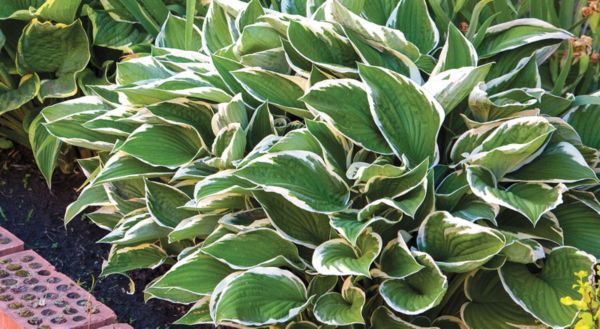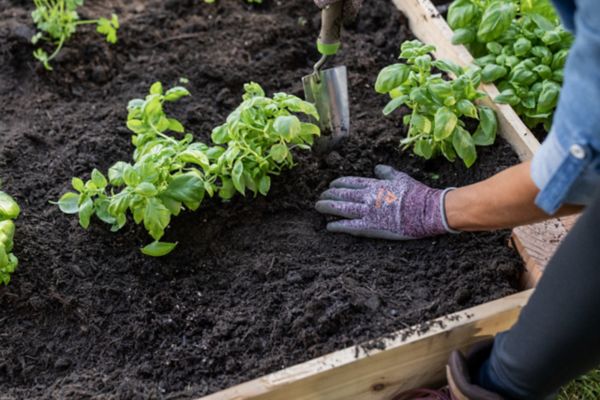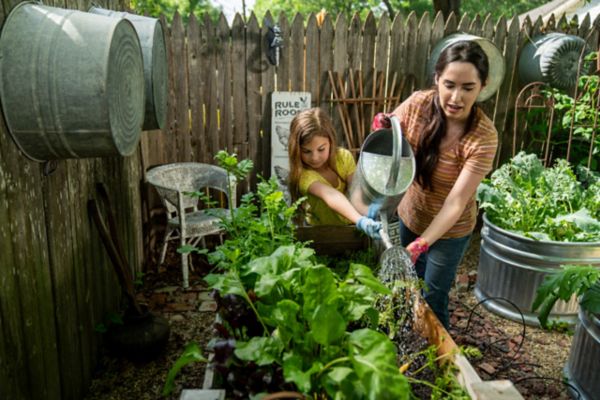How to Grow Mint
Authored by Leah Chester-Davis
Mint belongs in every herb garden and is a great plant for beginners. It is easy to grow and fast growing. The plant has an upright growth habit with slightly serrated, dark green foliage and a distinctive fragrance. It attracts pollinators, which is a bonus.
Mint gives a flavorful punch to both drinks and culinary dishes. It provides a refreshing note to both alcoholic and non-alcoholic beverages. A few leaves added to iced water or iced tea make them particularly enjoyable on hot summer days. To elevate the flavor even more, steep mint leaves in boiling water for a few minutes. This herb even has a drink named for it, the mint julep, which is the official drink of the Kentucky Derby. Cheers!
When it comes to culinary dishes, mint can be used for both savory and sweet dishes. A mint syrup is a perfect complement to fresh peaches, berries, and watermelon. Use the mint leaves as a garnish. Fresh mint leaves are often used in Vietnamese spring rolls and salads. It is popular in Mediterranean and Middle Eastern salads that use different grains and pastas. It gives a lift to spring pea salad. It can even be made into a pesto. Mint and lamb are classic pairings, but it can be served with chicken, beef, pork, or fish.
The beauty of growing this herb is that you will likely have plenty of mint to use in numerous ways. If you like to try different flavors and different dishes, mint offers many possibilities.
Mint is quite prolific, and some would say invasive. Do not let that deter you. Simply keep it contained by planting in a pot, and let the enjoyment begin.
There are hundreds of mint varieties, and spearmint (Mentha spicata) and peppermint (Mentha x piperita) are among the most popular. It can be fun to try others as well, such as pineapple mint, chocolate mint, apple mint, or orange mint.
About mint
| Botanical name: | Mentha |
| Common name: | Mint |
| Plant type: | Hardy perennial, depending on type of mint and region of country |
| Size: | 1- to 3-feet tall |
| Sun exposure: | Full sun |
| Soil type: | Rich, well-drained; adapts to numerous soil types |
| Soil pH: | 5.5 to 6.0 |
| Hardiness zones: | 4 to 9 |
| Average first frost: | Varies by region |
| Average last frost: | Varies by region |
| Container friendly: | Yes, and recommended |
| Beginner friendly: | Yes |
Growing

Mint does best in full to partial sun. In particularly hot climates it may benefit from afternoon shade. It can handle hot and humid conditions as well.
Mint grows best in slightly acidic soil, 5.5 to 6.0 pH. A soil test will provide information on your soil pH and recommendations for any needed amendments. Soil test kits are available from your county Extension office and may be free or a nominal charge.
This herb likes rich, moist, well-drained soil but adapts well to many conditions.
Before planting, add a couple of inches of compost in your garden if burying an open-ended container in the ground (see below for guidelines). If growing in a container aboveground, use a potting mix.
Mint is quite prolific, and some would say invasive. Do not let that deter you. Simply keep it contained by planting in a pot, and let the enjoyment begin.
Planting

Mint can be grown from seeds or transplants. Utah State Extension cautions that mints readily hybridize between different types, so plants grown from seed often fail to be true to type. For specific cultivars or varieties, it’s best to buy established plants or take cuttings or divide an established plant.
If you like mint and plan to harvest frequently, plant a couple of plants. If you plan to dry mint, or you want to provide a treat for pollinators, add extra plants. If growing several mint plants, space 12- to 18-inches apart.
Mint is a go-getter. It is easy to grow, and it grows quickly. It spreads by underground rhizomes and stolons or stems that grow just above the soil surface. It can quickly take over an herb garden. The best way to avoid this is to plant in a container. If you wish to add mint to a raised bed or other space in the garden, consider planting mint in a container that has the bottom removed and then burying the container. Leave an inch or two of the container above the soil line. Clip away any of the mint that outgrows the container to prevent it from rooting.
The plant will produce spikes with tiny violet flowers. It is often recommended to pinch off the flower spikes when they appear to maintain the flavor of the leaves, though some believe the leaf flavor is enhanced after the flowers have formed. If you have more than one mint plant, you can compare for yourself by removing flowers from one plant and leaving them on the other to see if you notice a difference in flavors. If you are a friend to pollinators, leave the blooms for bees and butterflies to enjoy.
Mint benefits from frequent harvesting of its leaves. It helps keep the plant looking its best and prevents it from becoming leggy.
Water mints regularly through the season, particularly in very dry conditions. Mint will need 1 to 2 inches of water per week. Avoid overwatering, which can promote diseases. Water at the base of the plant so the foliage stays dry, which lessens chances of foliar diseases.
At the end of the growing season and before winter, cut the plant back close to the ground.
In warmer regions of the country, mint will overwinter outdoors. In cold climates, North Dakota State Extension recommends peppermint as the hardiest. Other mints will likely need to be brought indoors into a garage during winter or mulched.
Fertilizing
Mint is like many other herbs in that it needs little to no fertilizer. Rich soil that has compost added will likely provide all the nutrients it needs.
- If adding a fertilizer application, use a slow-release fertilizer in the spring. Apply sparingly. Utah Extension recommends one teaspoon of 16-16-16 fertilizer per plant in the spring. If using an organic option, follow label directions.
Controlling Pests, Diseases, and Other Problems
Mint has few issues with pests and diseases.
- On occasion spider mites, aphids, or whiteflies can bother a plant. Arizona Extension recommends mixing one tablespoon of liquid dishwashing detergent in one gallon of water. Do not use lemon-scented soap. Spray the leaves on both the top and bottom. Repeat the spray after a week, and as needed but no more than four applications during a one-month period. Too much soap can injure the plant.
- Verticillium wilt, powdery mildew, and leaf rust can affect mints but typically are not an issue in home gardens. If you see orange, yellow, or black spots on the leaves, discard the infected plant. Do not add it to the compost pile.
Place mint near a walkway or other spot in your garden where you can enjoy its delightful scent as you brush against it.
Harvesting and Storing

When plants reach about four inches tall, snip or harvest leaves as needed. Regular harvesting keeps the plant producing new growth, which has the most flavorful leaves. Harvest the plants late in the morning after the dew has dried or evaporated.
Storing
Mint can be stored in the refrigerator. Wrap dry mint sprigs in a paper towel and place in a plastic bag. Use as needed. It will last up to a week. Bunches of mint sprigs can also be placed in a glass or small vase of water and left on the countertop, lasting about a week.
Mint can be dried. Because it is considered a tender-leaf herb, it will need to be dried in a dark, dry place that has low humidity. Place a bundle of mint in a brown paper bag and store in a cool, dark, dry room. After 2 or 3 weeks, remove the dried leaves and store in an air-tight container.
Mint can also be frozen, either by placing individual leaves on a cookie sheet to freeze and then storing in a freezer bag or other container, or by chopping the leaves and placing in an ice cube tray and covering with water. Freeze, then place the mint cubes in a ziptop bag. This makes it easy to retrieve as little or as much as you wish.
Harvest the plants late in the morning after the dew has dried or evaporated.
Expert Tips

- Mint is easy to propagate. Simply take a cutting and place in a container of water. After roots appear, plant in soil. Cuttings can also be placed directly in potting soil to root.
- Harvest mint leaves frequently to encourage full, bushy growth.
- If you are a mint lover, plant two or three kinds of mint to enjoy. Seek out local herb associations, herb fairs, farmers markets, or check with a local garden center for a variety of options.
- Even if you do not plan to use mint for culinary purposes, it is a worthwhile plant to attract pollinators.
Frequently asked questions
Is mint a good plant to use in a container with other plants?
While mint is a great container plant, and it is best to grow in containers to keep it from taking over your garden, it is not a good plant to add to a container where you are growing other plants. Mint is quite aggressive and will crowd out other plants. Give mint its own space.
Will mint grow in shade?
Mint prefers full sun but will grow in partial shade and will welcome afternoon shade in hot climates.
Should I divide my mint plant?
Mint can benefit from dividing it at the end of the growing season. Simply dig up and cut or divide into sections. Transplant the extra sections or share with a friend to give them their start of this popular herb.






